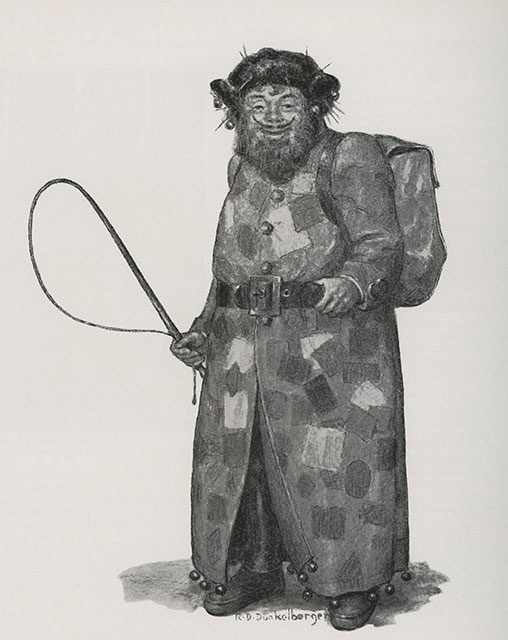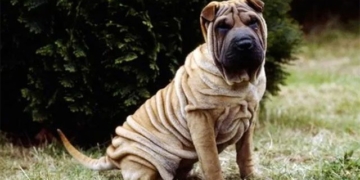Belsnickel is not a fictional character, but a real figure in German folklore.
Belsnickel shares some similarities with Santa Claus, but his terrifying appearance and harsh approach set him apart from his more benevolent counterpart.
Despite this, he is still revered today by the descendants of German immigrants in America.
The Grimy Santa Claus
Belsnickel is not a fictional character but a genuine figure in German folklore. He has long been celebrated by the descendants of German immigrants to the United States.
German communities in Pennsylvania often incorporate this character into their Christmas traditions, enjoying his method of punishing naughty children and rewarding those who behave well.
The legend of Belsnickel originates from the Palatinate region in southwestern Germany, where he is sometimes referred to as “Kriskinkle,” “Beltznickle,” “Pelsnichol,” and even “The Christmas Woman” due to his occasionally feminine attire.
The name “Belsnickel” is a combination of the German words bels (fur) and niken (Saint Nicholas).
Belsnickel may be based on an earlier folkloric figure, Knecht Ruprecht, a servant of Saint Nicholas, who first appeared in written records in the 17th century and in the works of the Brothers Grimm. Jacob Grimm compared him to a kobold or goblin.
In contrast to Santa Claus, who is usually depicted as gentle, jolly, and polite in red and white attire, Belsnickel’s appearance is entirely different.
In German folklore, Belsnickel has a frightening look with a grimy face, dirty, tattered clothes, often adorned with branches, and even deer antlers. He carries a soft branch used for whipping.
Yet, this German mythical figure plays a similar role in determining whether children are good or naughty and delivering gifts during Christmas. However, he carries out his duties in a very different manner.
Reward and Punishment

Belsnickel – The Fearsome Santa Claus.
Belsnickel typically appears at children’s homes one or two weeks before Christmas.
Instead of descending through the chimney like Santa Claus, he knocks on windows with his whip and barges into the house, beginning to interrogate the children about their behavior.
Children must answer Belsnickel’s questions, and they may even be asked to recite passages from the Bible.
Those who can convince Belsnickel of their good behavior will be rewarded. In contrast, those who cannot answer his questions or fail to demonstrate their good deeds will be punished with the whip he carries.
This German tradition was brought to places like New York and Pennsylvania by immigrants.
The person chosen to portray Belsnickel is often an older member of the community, who dresses up as this quirky Christmas figure by wearing a mask and a fur coat, appearing a few hours after dark. He or she carries a large sack filled with sweets, nuts, fruits, and a long, chestnut-colored whip.
Other Santas
Belsnickel is an unusual Christmas character, but he is not the only one resembling Santa Claus in European folklore.
Alongside various Santa Claus variants in Europe—such as Sinterklaas and St. Nicholas—there are also several scarier Christmas figures inspired by Belsnickel.
In France, Père Noël (Father Christmas) is accompanied by Père Fouettard, who bears some resemblance to Belsnickel in that he is covered in soot and wears ragged clothes. Like Belsnickel, Père Fouettard is notorious for punishing misbehaving children and tossing them pieces of coal.

Santa Claus. (Illustrative image/INT).
From Belsnickel’s homeland in Germany, there is also the frightening Christmas legend of Krampus. Like Belsnickel and Père Fouettard, Krampus is famous for punishing naughty children. Unlike the other two figures, Krampus has pagan origins and may stem from Norse gods.
Additionally, Krampus focuses specifically on punishing naughty children. German folklore tells of a half-goat creature that stuffs naughty children into a sack to eat them or drags them back to his lair to make them repent for their misdeeds.
Thus, compared to the aforementioned “Santa Clauses,” Belsnickel falls into the good category. Like Père Fouettard, Krampus, and others, he plays an important role in Christmas traditions by ensuring children keep their promises to behave.
In any case, those hosting Christmas celebrations everywhere should be mindful as the holiday approaches. The scratching you hear at your window may not be a branch outside but Belsnickel and his whip. Whether loved or hated, Belsnickel remains a famous Christmas legend respected by many.
“Santa Claus” Belsnickel was very popular in the 19th century, even persisting in many areas until the early 20th century. This tradition largely vanished after World War II but has made a comeback in recent years, with this intriguing character still sincerely revered by Germans in Pennsylvania.




















































